click on images to enlarge
HISPANO-AMERICAN SILVER: THE "TOPOS"
"A spoon with large bowl and pointed stem"
This is the definition I used for an odd 'spoon' bought in the San Maurizio Market in Venice.
Little information was obtained from the seller: ... item made in the 18th/19th century ...French provenance.
Several odd, uncommon and unusual objects are present in my collection, but this 'spoon' was for many years
my preferred "question mark".
The 'spoon' was undoubtedly of French provenance and had the 'swan' used since 1893 to mark
silver items of unknown origin sold in French public auctions.
It is undoubtedly ancient (18th or 19th century), but its appearance doesn't correspond to any
other spoon I had previously seen.
The pointed stem resembled to 18th century 'tea mote spoon', but the bowl had no piercing.
|
|
Mote spoons were used to skim floating tea leaves and tea dust (motes) off the surface of a cup of
tea. They were a late 17th century invention and used mostly as part of tea-services. |
The bowl was too large (5,5 cm. - 2 1/8 in.) and unsuitable for eating use, and the hypothesis
'wedding spoon' was not convincing
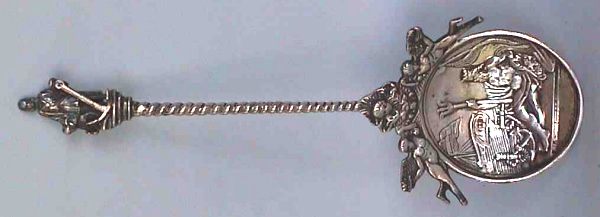 |
silver wedding spoon: Germany, end of 19th century
On the top, a figure (maybe Christopher Columbus) with an anchor and an 'indio'
(www.silvercollection.it) |
This spoon continued to be a question for me.
But, unexpected, the solution arrived some time ago: this object is not a spoon but a "TOPO", a long pin used by 'Cholas' women (original population
of Bolivia) to shut down their shawls.
Three "topos" were presented in the exhibition 'Trois siécles d'orfevrerie
Hispano-Américaine' (Three centuries of Hispano-American silver) held in Paris in 1986. In the
Exhibition's catalog Adolfo Luis Ribera (National Academy of Arts of Buenos Aires) writes:
..... coming from the present Bolivia territories, the 'topos' (or 'tupo') are, in quichua language, the
long pins used by women indios (or 'cholas') to keep their shawls closed...
The pin's heads are of great interest, with semi-precious stones or pearls....
Sometime the pin's heads are enriched with embossed motifs standing out the shawl's cloth, or
chiselled on bowls similar to spoons.....
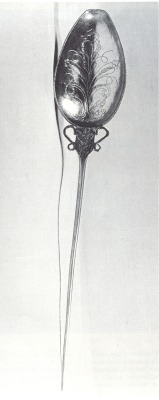 |
TOPO (left)
Bolivia, 19th century
chiselled silver
long 31,2 cm; max large 5,7 cm.
big shawl's pin with head in the shape of a spoon decorated with floral motifs engraved
and chiselled.
Between the head and the pin a flat motif with scrolls on the sides
(Hispano-American Art Museum - Buenos Aires)
TOPO (right)
long 29,4 cm.; max large 5,5 cm.
big shawl's pin with head in the shape of a spoon.
Between the head and the pin a flat motif with scrolls on the sides
(www.silvercollection.it) |
 |
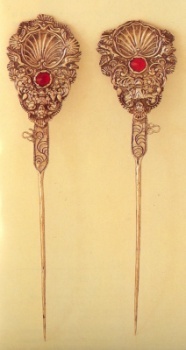 |
PAIR OF TOPOS (left)
High Peru, 18th century
embossed and chiselled silver
long 25,6 cm; large 6 cm.
Almond shape head with irregular rim. A shell on the top, surrounded by smaller shells,
birds and scrolls. On the lower part, a human figure, upside down, on floral decoration.
A red stone on the middle.
(Hispano-American Art Museum - Buenos Aires)
PAIR OF TOPOS (right)
Bolivia, 19th century
embossed, cast and chiselled silver,
long 49 cm.; max large 12,7 cm.
Monogram IM on the heart. Egg shaped heads. Flowers with gold heart on the middle. Symmetric
vegetable decorations with two peacocks (on the top), flowers, and two long neck birds (lower
side). White and red semi-precious stones.
(Hispano-American Art Museum - Buenos Aires) |
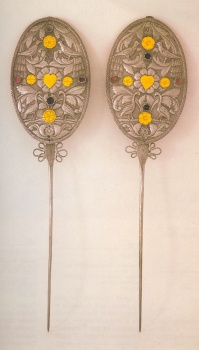 |
 |
 |
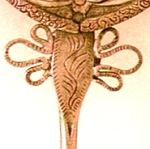 |
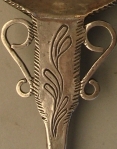 |
monogram IM (Hispano-American Art Museum - Buenos Aires) |
|
floral motifs engraving (Hispano-American Art Museum - Buenos Aires) |
|
|
Plaza de Recocijo de Potosi (1830, oil painting)
Potosi (now in Bolivia, once in Vice-Kingdom of Rio de La Plata). The discovery of ore in
silver-rich Cerro Rico (rich hill) prompted the foundation of the city of Potosí in 1545.
Large-scale excavation began in the site immediately and the city's population increased to
nearly 200,000, making it one of the largest and wealthiest city in Latin America. During the
early 19th-century, struggles for independence caused much destruction and the city's wealth
was removed to
Europe or to other parts of the Spanish realm. By then the population dropped to less than
10,000. By the time of independence in 1825, the mines of the Cerro Rico were almost exhausted
and Potosi's economy has never recovered. |
BIBLIOGRAPHY
Trois siècles d'orfèvrerie Hispano-Américaine - Association Française d'Action Artistique. Paris, 1986
Giorgio Busetto - 2006 -
www.silvercollection.it
this article is published on  website website
|



















